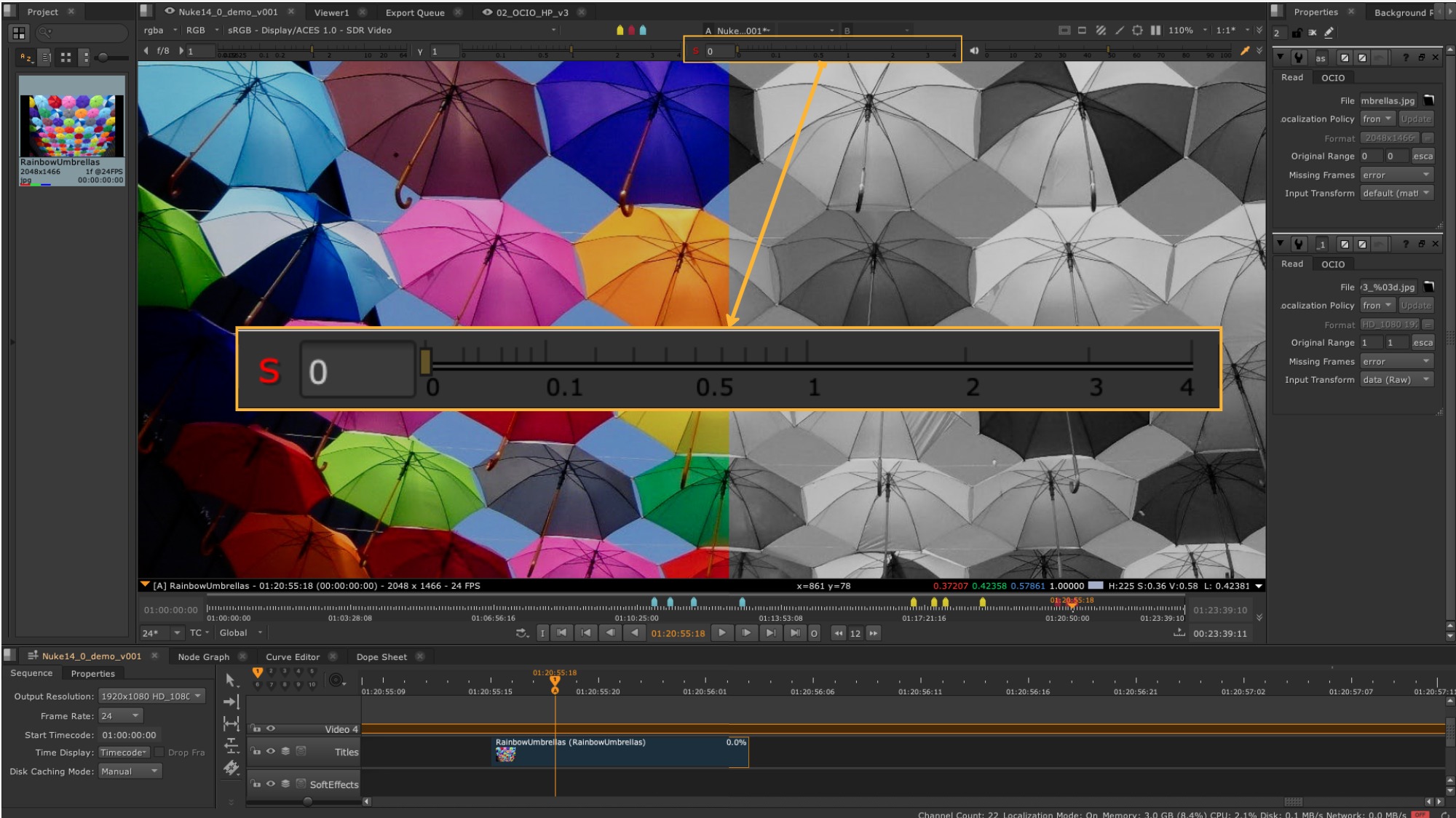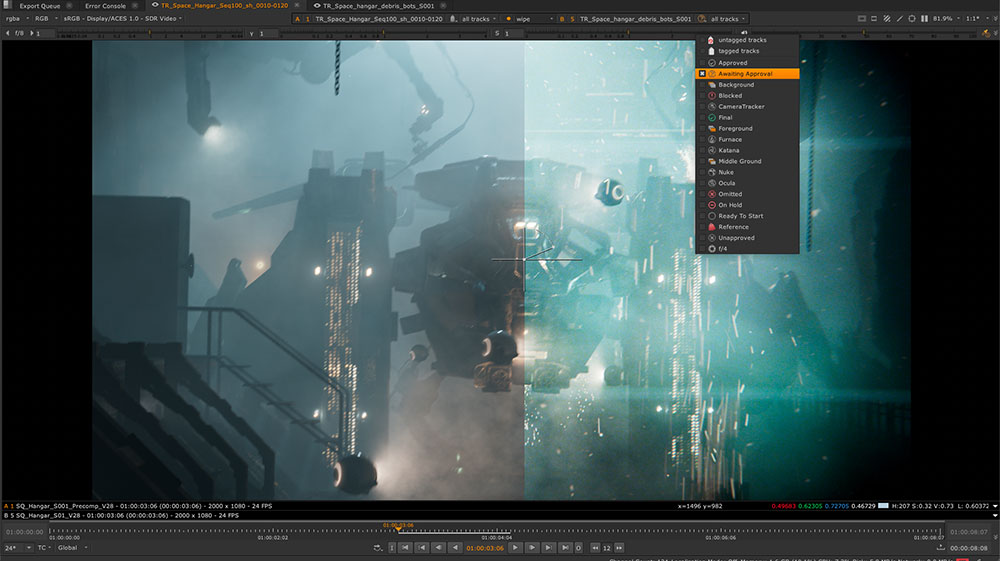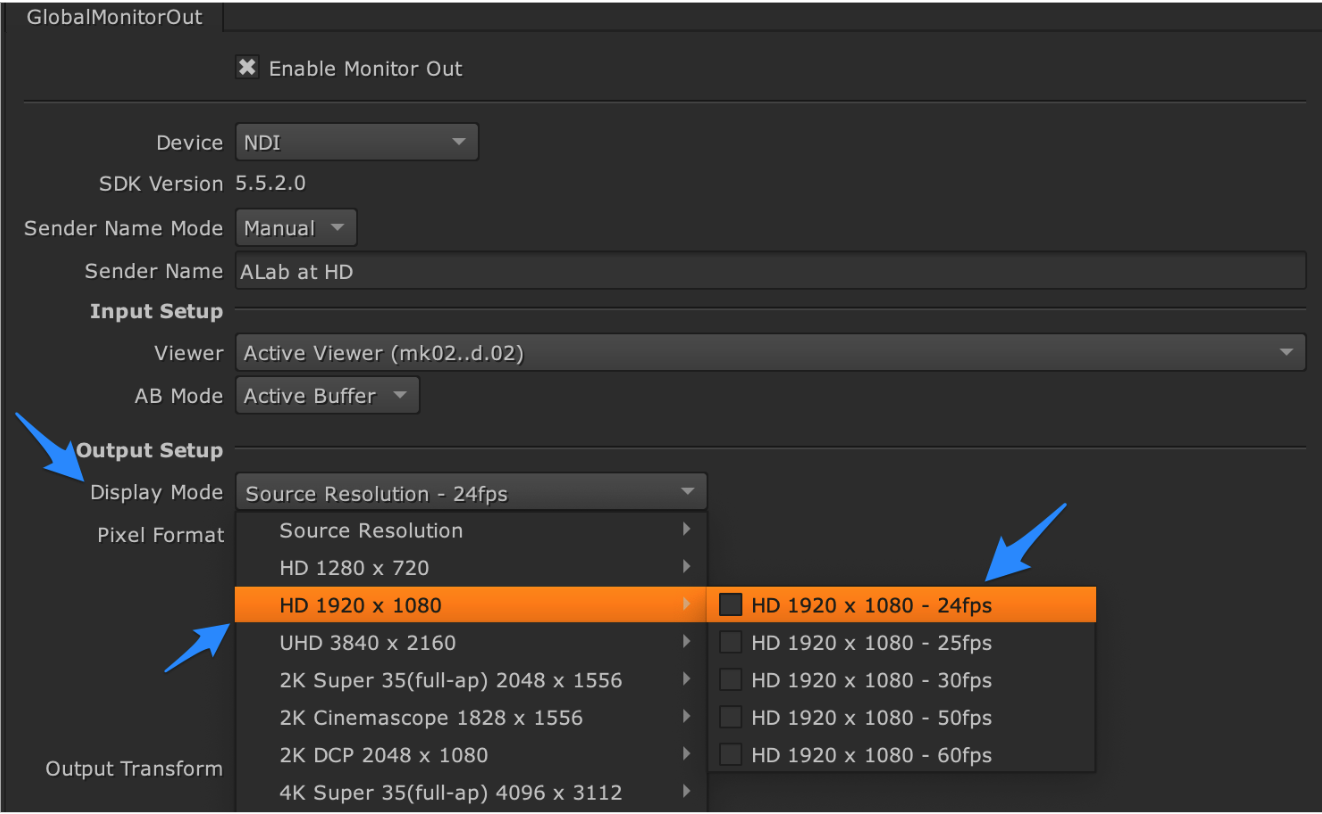What's New in Nuke, Nuke Studio, and Hiero 15.1
Nuke 15.1 delivers future-facing pipeline tools, with OpenAssetIO, full OTIO round-trip support and custom USD versions. Plus UI updates and improved Review, CopyCat training, and more for greater artist control.
Viewer Saturation Slider
In Nuke 15.0 we added a saturation slider to the Comp Viewer. This small but much-requested feature was designed to help you check your work, much like the Gamma and Gain controls already available. For this release we’ve added the Saturation Slider to the Timeline Viewer, so that you can review the saturation levels across your shots in context.

See Adjust Display Gain, Gamma and Saturation
Updated A/B Compare controls
Enhancing review even further, Nuke 15.1 includes a redesign for the A/B Compare tools. Cut down the time you spend on Quality Control of versions, side by side comparison, and analyzing differences — with updates that make the Nuke Viewer A/B compare toolset easier to use, and more powerful when handling shots with long names.

See Comparing Media.
3D System - Time Remapping (beta)
As we continue to evolve the new USD-based 3D system, this new release makes working with time in the new 3D system simpler and more efficient. Including updates to existing time nodes such as TimeOffset and Framehold, to allow you to work with these nodes in the new 3D system and the ability to work in a new Fractional Time mode for even greater control over 3D data. Plus the GeoImport and GeoReference nodes have new time remapping options for greater control when working with 3D animation data.
Improved 3D stage building (beta)
We’re continuously making adjustments at each level of the new 3D system to maximize performance and responsiveness when handling the large amounts of data required when working in 3D scenes. For this update we’ve improved the backend to make stage building in large 3D scenes faster and more responsive. Depending on the stage involved this could mean tasks that previously took seconds, are now instantaneous. With the new system in beta, we look forward to hearing your experience on our community forum.
CopyCat UI Improvements
Manage multiple training runs with ease with UI improvements to CopyCat in Nuke 15.1. Using CopyCat for more complex shots requires an iterative process of training, validating, and refining the model to achieve the required quality. Until now, you could only resume or create inference nodes from the most recent training run, and the only way to remove previous training runs was to jump out and delete the files manually. The new context menu in the Runs table adds the options, resume, delete, create inference from, and change the visibility of training checkpoints.
See Train and Monitor the Network.
CopyCat Mixed Precision Training
Train CopyCat even faster with new mixed-precision training. When you select this option CopyCat will adapt the numerical precision used during different stages of its neural network training. For operations that require less precision such as linear layers CopyCat will use half-precision floating point, whilst maintaining full floating point for higher precision operations. This change reduces the GPU memory footprint and allows CopyCat to train up to 2x faster without degrading output fidelity.
PyTorch Upgrade
We have upgraded PyTorch, the library underpinning our machine learning tools. This upgrade provides additional performance and stability improvements, particularly for Mac users, and will make possible the conversion of machine learning models for use in Nuke, which have trained with more recent versions of PyTorch.
NDI Resolution Control
Hold more efficient review sessions with Nuke 15.1’s updates to Monitor Out. New Display Mode knob controls give you the flexibility to control your NDI stream resolution and frame rate without impacting your local timeline display. This means you can hold review sessions for high resolution projects without the need to choose between performance and quality, or compromising your timeline. Ensuring clients, artists, and the full team see the same picture.

See Streaming Viewer Output Over the Internet with NDI®.
Full OTIO Roundtrip Support
First introduced in beta in Nuke 13.2 with continuous refinement based on your valuable testing and feedback since, OpenTimeline IO is now ready to take your workflows to the next level. This release includes full OTIO roundtrip support, providing full pipeline ability and a smoother editing experience. Make fast work of importing and exporting timelines, easily share timelines between different pipeline applications, and enjoy increased flexibility, whatever your editing needs.
See Exporting Sequences as EDL, OTIO, and XML.
BlinkScript unlocked layer channel mapping
Streamline your BlinkScript workflows with the new unlocked layer channel mapping. In this update we’ve extended the BlinkScript node allowing you to pass up to four channels of any kind of image layer into an input pipe or through node output. Now you can easily build channels such as Motion and Depth into your custom Blink Effects with the unlocked multiple image inputs. This enhanced control gives you more power to customize workflows for faster, smoother post-production.
See Loading, Editing, and Saving Kernels.
BlinkScript documentation & learning resources
With the BlinkScript node you can create custom effects once and make them available on any supported device. Meaning that artists can use the same effects across devices without the need to rebuild them from scratch. The Blink framework at the core of BlinkScript is incredibly powerful when used to develop custom tools and plug-ins for your pipeline and workflows. For this release we’ve rebuilt the Blink documentation from the ground-up, to support artists and developers with the resources needed to create game-changing Blink-based effects.
See the BlinkScript Documentation for more information.
USD version selection & 23.11 update (beta)
Use the USD version that works for you and your pipeline in Nuke 15.1. To make your pipeline more flexible while ensuring you receive the benefits of USD, we’ve made swapping the USD version you use with Nuke even easier. A new environment variable, plus updated and reorganized subfolder storage for USD data using the same structure as a USD build makes it easier to swap versions without impacting your workflow. The latest Nuke update also includes support for USD 23.11, including new features and bug fixes from Pixar, meaning if you just want to get up and running with a recent version of USD you can.
See Custom USD Versions.
OpenAssetIO
Further improving Nuke’s OpenAssetIO integration to support larger, more flexible pipelines, Nuke 15.1 includes extended OpenAssetIO support to additional ingest nodes. To allow closer integration with external asset managers and render farms, we are expanding Nuke’s OpenAssetIO integration and adding support for Frame Range, Original Range and Colorspace properties, as well as additional ingest nodes.
See OpenAssetIO.
File Format SDK Updates
Stay up-to-date with industry standards with support for the latest SDKs and cameras. Supported in Nuke 15.1 are – DNxHD .mxf writing for enhanced Avid-based workflows, RED R3D SDK 8.4.0 including new metadata reading capability, MOV Data Range for greater image processing control when read into Nuke, and Sony RAW SDK 5.0.0.
